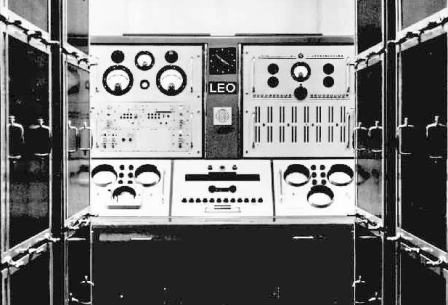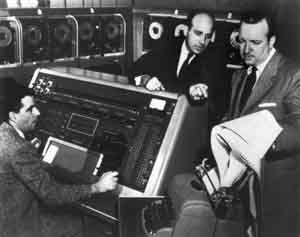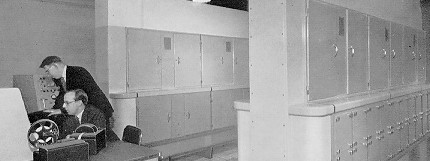Who Was First?
The first commercial computer was the Ferranti Mark 1, built by Ferranti and delivered to the University of Manchester in February 1951 and was used primarily for scientific research.
LEO

The LEO I (Lyons Electronic Office I) was the first computer used for commercial business applications. In October 1947, the directors of J. Lyons & Company, a British catering company famous for its teashops but with strong interests in new office management techniques, decided to take an active role in promoting the commercial development of computers. The LEO I computer became operational in April 1951 and ran the world’s first regular routine office computer job. On 17 November 1951, the J. Lyons & Company began weekly operation of a bakery valuations job on the LEO. This was the first business application to go live on a stored program computer.
Modeled closely on the Cambridge EDSAC, LEO I ran its first business application in 1951. In 1954 Lyons formed LEO Computers Ltd to market LEO I and its successors LEO II and LEO III to other companies. LEO Computers eventually became part of English Electric Company (EELM) and then International Computers Limited (ICL) and ultimately Fujitsu. LEO series computers were still in use until 1981.
Technical description
LEO I’s clock speed was 500 kHz, with most instructions taking about 1.5 ms to execute. To be useful for business applications, the computer had to be able to handle a number of data streams, input and output, simultaneously. Therefore, its chief designer, Dr. John Pinkerton, designed the machine to have multiple input/output buffers. In the first instance, these were linked to fast paper tape readers and punches, fast punched card readers and punches, and a 100 line a minute tabulator. Later, other devices, including magnetic tape, were added. Its ultrasonic delay line memory based on tanks of mercury, with 2K (2048) 35-bit words (i.e., 8¾ K bytes), was four times as large as that of EDSAC.
UNIVAC

The first UNIVAC (UNIVersal Automatic Computer) was accepted by the United States Census Bureau on March 31, 1951, (although it was not delivered until a year later) and was dedicated on June 14 that year making it the first commercial computer installed in North America. Of historical note, a UNIVAC 1 owned by the US Atomic Energy Commission was used by CBS to predict the result of the 1952 presidential election. With a sample of just 1% of the voting population it famously predicted an Eisenhower landslide while the conventional wisdom favored Stevenson.
The UNIVAC was designed principally by J. Presper Eckert and John Mauchly, the inventors of the ENIAC. Design work was started by their company, Eckert–Mauchly Computer Corporation, and was completed after the company had been acquired by Remington Rand.
Remington Rand eventually sold 46 machines at more than $1 million each ($9.1 million in 2014 dollars). UNIVAC was the first “mass produced” computer. It used 5,200 vacuum tubes and consumed 125 kW of power. Its primary storage was serial-access mercury delay lines capable of storing 1,000 words of 11 decimal digits plus sign (72-bit words).
